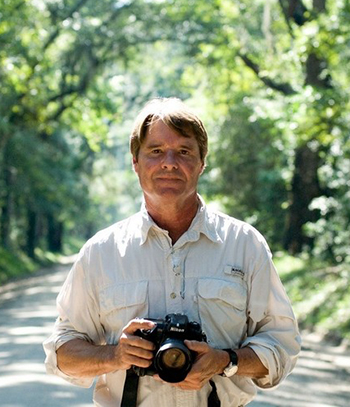“The view from above these fields is absolutely captivating,” he says. He recently exhibited his aerial rice-field photography at Charleston’s City Gallery at Waterfront Park. The exhibition, Remnants of the Rice Culture: Agricultural History as Art, included 75 photographs of fields stretching from Florida into North Carolina, approximately 400 miles, where more than 100 varieties of rice once grew.
The photographs capture a lesser-known history of the South—and a story of humanity. “Looking down at these rice fields,” he says, “I see (or imagine) eight or so generations of enslaved people constructing and cultivating those fields.”
South Carolina was the largest producer of rice in America during the Colonial period, dependent entirely on the labor of slaves. “Rice was a huge and profitable industry preceding cotton by about 100 years,” Soliday says. The intricate fields, designed with signature canals and ditches for irrigation, stretching hundreds of miles along the Carolina coast, “were constructed by hand and shovel alone.”
Soliday’s images provide a closer look not only at the history of rice cultivation but also at the contributions of African-Americans and the central role of slavery in the making of America.
“The very core of it all has always been the simple thought of giving credit where credit is due,” he says of the project. Consequently, the Smithsonian Institution has taken notice of the photos, recently acquiring a selection that will be on view at the National Museum of African American History and Culture, scheduled to open on the National Mall in 2016.
In addition to capturing this piece of American history, Soliday’s work simultaneously preserves a landscape that, a century from now, won’t exist. “So much is already gone with time and natural erosion,” he says. “The landscape represents, or is reflective of, many people, values and sheer history. It can’t be preserved physically, but being preserved in photography may be valuable in the future.”
More of Soliday's photographs
A TRIBUTE TO HIS SON
Soliday dedicated the City Gallery exhibition to his son, David Shriver Soliday IV, who took his own life on July 1, 2014, at age 17, not long after sustaining his third severe concussion in 18 months. By sharing this personal tragedy, Soliday hopes to educate other families about concussions and suicide, and perhaps spare them the same pain. In the dedication he wrote for the exhibition, Soliday said that while he does not readily bring his personal life into his work, “using this soapbox to spread the word about my son’s unexpected suicide and its probable connection to concussion is well worth a hit if it saves just one child.”


